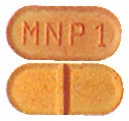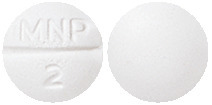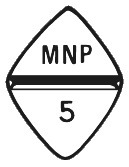SUMMARY CMI
Minipress®
Consumer Medicine Information (CMI) summary
The full CMI on the next page has more details. If you are worried about using this medicine, speak to your doctor or pharmacist.
1. Why am I using Minipress?
Minipress contains the active ingredient prazosin. Minipress is used to treat high blood pressure, also called hypertension, benign prostatic hyperplasia or BPH ('prostrate trouble') in men waiting for prostate surgery, Raynaud's disease where the fingers become white and painful when cold, and certain types of heart failure.
For more information, see Section 1. Why am I using Minipress? in the full CMI.
2. What should I know before I use Minipress?
Do not take if you have ever had an allergic reaction to Minipress or any of the ingredients listed at the end of the CMI.
Talk to your doctor if you have any other medical conditions, take any other medicines, or are pregnant or plan to become pregnant or are breastfeeding.
For more information, see Section 2. What should I know before I use Minipress? in the full CMI.
3. What if I am taking other medicines?
Some medicines may interfere with Minipress and affect how it works.
A list of these medicines is in Section 3. What if I am taking other medicines? in the full CMI.
4. How do I use Minipress?
- Start with a low dose of 0.5 mg (half a 1 mg tablet) taken twice a day.
More instructions can be found in Section 4. How do I use Minipress? in the full CMI.
5. What should I know while using Minipress?
| Things you should do |
|
| Things you should not do |
|
| Driving or using machines |
|
| Drinking alcohol |
|
| Looking after your medicine |
|
For more information, see Section 5. What should I know while using Minipress? in the full CMI.
6. Are there any side effects?
Side effects include feeling sick, vomiting or dry mouth, constipation, diarrhoea, weakness or lack of energy, headache or drowsiness and stuffy nose. Serious side effects include fast or pounding heartbeat, chest pain, fainting, dizziness or lightheadedness when standing up, shortness of breath or difficulty breathing, blurred vision, rash, itching or other skin problems, sharp pain in the stomach or back, persistent painful erection of the penis which occurs without sexual arousal, tingling or numbness of the hands or feet, swelling of the hands, feet or ankles and feelings of nervousness or depression.
For more information, including what to do if you have any side effects, see Section 6. Are there any side effects? in the full CMI.
FULL CMI
Minipress® (min-e-press)
Active ingredient(s): prazosin (praz-o-sin)
Consumer Medicine Information (CMI)
This leaflet provides important information about using Minipress. You should also speak to your doctor or pharmacist if you would like further information or if you have any concerns or questions about using Minipress.
Where to find information in this leaflet:
1. Why am I using Minipress?
2. What should I know before I use Minipress?
3. What if I am taking other medicines?
4. How do I use Minipress?
5. What should I know while using Minipress?
6. Are there any side effects?
7. Product details
1. Why am I using Minipress?
Minipress contains the active ingredient prazosin. Minipress belongs to a family of medicines called alpha blockers. These medicines work by relaxing muscles in the walls of blood vessels and reducing the resistance to blood flow. They also relieve prostate problems by relaxing muscles in the prostate gland and increasing the flow of urine.
Minipress is used to treat high blood pressure, also called hypertension, benign prostatic hyperplasia or BPH ('prostrate trouble') in men waiting for prostate surgery, Raynaud's disease, where the fingers become white and painful when cold, and certain types of heart failure.
When used to treat high blood pressure or heart failure, Minipress is often used in combination with other medicines.
Ask your doctor if you have any questions about why Minipress has been prescribed for you.
Your doctor may have prescribed it for another reason.
2. What should I know before I use Minipress?
Do not take Minipress if:
- you are allergic to prazosin, or any of the ingredients listed at the end of this leaflet.
- Symptoms of an allergic reaction may include:
- shortness of breath
- wheezing or difficulty breathing
- swelling of the face, lips, tongue or other parts of the body
- rash, itching or hives on the skin.
- always check the ingredients to make sure you can use this medicine.
- any other alpha blocker medicine (e.g. Hytrin).
- You are under 12 years of age. Minipress is not recommended for use in children under 12 years of age.
If you are not sure whether you should be taking Minipress, talk to your doctor or pharmacist.
Check with your doctor if you:
- have allergies to:
- any other medicines, foods, preservatives or dyes. - Have any other medical conditions including:
- heart problems such as heart failure or angina
- kidney or liver problems. - Take any medicines for any other condition.
If you have not told your doctor about any of the above, tell them before you start Minipress.
During treatment, you may be at risk of developing certain side effects. It is important you understand these risks and how to monitor for them. See additional information under Section 6. Are there any side effects?
Pregnancy and breastfeeding
Check with your doctor if you are pregnant or intend to become pregnant.
Talk to your doctor if you are breastfeeding or intend to breastfeed.
If you have not told your doctor about any of the above, tell them before you start Minipress.
3. What if I am taking other medicines?
Tell your doctor or pharmacist if you are taking any other medicines, including any medicines, vitamins or supplements that you buy without a prescription from your pharmacy, supermarket or health food shop.
In particular, tell your doctor if you are taking:
- medicines used to lower blood pressure
- fluid tablets (diuretics)
- medicines to treat impotence (erectile dysfunction).
Some medicines may interfere with Minipress and affect how it works.
Other medicines that lower high blood pressure may have an additive effect with Minipress and make your blood pressure too low. As a result, their dose may need to be changed when Minipress is started.
Check with your doctor or pharmacist if you are not sure about what medicines, vitamins or supplements you are taking and if these affect Minipress.
Your doctor or pharmacist has a complete list of medicines to be careful with or avoid while taking Minipress.
4. How do I use Minipress?
How much to take
- Minipress is usually started at a low dose of 0.5 mg (half a 1 mg tablet) taken twice a day.
- Follow the instructions provided and use Minipress until your doctor tells you to stop.
Starting with a low dose reduces the risk of too great a drop in your blood pressure which can make you dizzy, lightheaded or faint.
Your doctor may gradually increase this dose as required. This may depend on your age, your condition and whether or not you are taking any other medicines.
Hypertension (high blood pressure)
The usual starting dose is 0.5 mg (half a 1 mg tablet) taken twice a day increasing to 1 mg taken two or three times a day. Your doctor may increase this up to 20 mg a day, taken in divided doses.
Heart failure
The usual starting dose is 0.5 mg (half a 1 mg tablet) increasing to 4 mg a day, divided into three or four doses. This may be increased by your doctor up to 20 mg a day, taken in divided doses.
Raynaud's disease
The usual starting dose is 0.5 mg (half a 1 mg tablet) taken twice a day. Your doctor may increase this up to 1 mg or 2 mg taken twice a day.
Benign prostatic hyperplasia (BPH)
The usual starting dose is 0.5 mg (half a 1 mg tablet) taken twice a day. Your doctor may increase this to 2 mg taken twice a day.
When to take Minipress
- Minipress should be taken at the same time each day.
When you first start taking Minipress or if your doctor increases your dose, take the first dose last thing at night, just before going to bed.
Be especially careful if you need to get up during the night, because you may feel dizzy and could fall.
How to take Minipress
- Swallow the tablets with a glass of water or other liquid.
- It does not matter if you take Minipress before or after food.
How long to take Minipress
Keep taking Minipress every day until your doctor tells you to stop.
If you are taking Minipress for high blood pressure, heart failure or Raynaud's disease, you may need to take it for a long time.
Minipress will help control these conditions, but will not cure them. Therefore, it must be taken every day.
If you are taking Minipress for prostate problems, you will only have to take it until your operation.
If you forget to use Minipress
Minipress should be used regularly at the same time each day. If you miss your dose at the usual time, and it is within 3 hours before your next dose, skip the dose you missed and take the next dose when you are meant to.
Otherwise, take it as soon as you remember, and then go back to taking your medicine as you would normally.
Do not take a double dose to make up for the dose you missed.
If you are not sure what to do, check with your doctor or pharmacist.
If you miss two (2) doses or more, you will need to restart at a low dose and build up again gradually to your usual dose.
- Ask your doctor how to do this.
If you take too much Minipress
If you take too much Minipress, you may feel lightheaded, dizzy, have a fast or irregular heartbeat, or you may faint.
If you think that you, a child or anyone else may have taken too much Minipress, you may need urgent medical attention.
You should immediately:
- phone the Poisons Information Centre
(by calling 13 11 26), or - contact your doctor, or
- go to the Emergency Department at your nearest hospital.
You should do this even if there are no signs of discomfort or poisoning.
5. What should I know while taking Minipress?
Things you should do
Get up slowly after you have been sitting or lying down.
Minipress can cause dizziness, lightheadedness and fainting, particularly if you get up too quickly. This is also more likely to occur if you have just started Minipress or the dose of Minipress has just been increased.
These symptoms can be dangerous, particularly if you are 65 years or older and have heart disease.
If you feel dizzy or lightheaded, lie down so that you do not faint. Then sit for a few moments before standing to prevent the dizziness from returning.
If these symptoms continue, tell your doctor.
A change in dose may be needed.
Call your doctor straight away if you:
- experience painful erections or if your erection continues for longer than four hours.
- become pregnant while taking Minipress
- are about to start any new medicines, tell your doctor that you are taking Minipress.
Remind any doctor or dentist you visit that you are using Minipress.
Things you should not do
- Do not give Minipress to anyone else, even if they have the same condition as you.
- Do not use Minipress to treat any other complaints unless your doctor tells you to.
- Do not stop taking Minipress, or lower the dosage, without checking with your doctor.
Your doctor will reduce your dose of Minipress gradually if you are to stop taking this medicine.
Driving or using machines
Be careful before you drive or use any machines or tools until you know how Minipress affects you.
Minipress may cause dizziness, lightheadedness or fainting in some people, especially after the first dose or after a dose increase. Blurred vision or drowsiness may also occur.
Make sure you know how you react to Minipress before you drive a car, operate machinery or do anything else that could be dangerous if you are dizzy, drowsy, or are not alert.
Drinking alcohol
Tell your doctor if you drink alcohol.
Be careful to limit the amount of alcohol you drink while taking Minipress. Also, take extra care during exercise or hot weather or if you have to stand for a long time.
Dizziness, lightheadedness, or fainting is more likely to occur if you drink alcohol, stand for a long time, exercise or the weather is hot.
Looking after your medicine
- Keep your tablets in their pack until it is time to take them.
- Keep them in a cool, dry place where the temperature stays below 30°C.
Follow the instructions in the carton on how to take care of your medicine properly.
Store it in a cool dry place away from moisture, heat or sunlight; for example, do not store it:
- in the bathroom or near a sink, or
- in the car or on window sills.
Do not use this medicine after the expiry date.
Keep it where young children cannot reach it.
When to discard your medicine
If your doctor tells you to stop taking Minipress, or the tablets have passed their expiry date.
Getting rid of any unwanted medicine
If you no longer need to use this medicine or it is out of date, take it to any pharmacy for safe disposal.
6. Are there any side effects?
All medicines can have side effects. If you do experience any side effects, most of them are minor and temporary. However, some side effects may need medical attention.
See the information below and, if you need to, ask your doctor or pharmacist if you have any further questions about side effects.
Side effects
If you are 65 years or older, you should be especially careful while taking Minipress. Report any side effects promptly to your doctor.
| Side effects | What to do |
| Speak to your doctor if you have any of these side effects and they worry you. These side effects are usually mild. |
Serious side effects
| Serious side effects | What to do |
| Call your doctor straight away, or go straight to the Emergency Department at your nearest hospital if you notice any of these serious side effects. |
Tell your doctor or pharmacist if you notice anything else that may be making you feel unwell.
Other side effects not listed here may occur in some people.
Reporting side effects
After you have received medical advice for any side effects you experience, you can report side effects to the Therapeutic Goods Administration online at www.tga.gov.au/reporting-problems. By reporting side effects, you can help provide more information on the safety of this medicine.
Always make sure you speak to your doctor or pharmacist before you decide to stop taking any of your medicines.
7. Product details
This medicine is only available with a doctor's prescription.
What Minipress contains
| Active ingredient (main ingredient) | 1 mg, 2 mg or 5 mg of prazosin |
| Other ingredients (inactive ingredients) | maize starch microcrystalline cellulose magnesium stearate sodium lauryl sulfate calcium hydrogen phosphate sunset yellow FCF (1 mg tablet only). |
Do not take this medicine if you are allergic to any of these ingredients.
This medicine does not contain lactose, or sucrose.
What Minipress looks like
1mg - orange, capsule-shaped tablets marked MNP 1 on one side and scored on the other (AUST R 10756)
2mg - white, round tablets marked MNP 2 on the scored side and plain on the other (AUST R 10757)
5mg - white, diamond shaped tablets scored on both sides, marked MNP 5 on one side (AUST R 10758)
Each box contains 100 tablets.
Who distributes Minipress
Pfizer Australia Pty Ltd
Sydney, NSW
Toll Free Number: 1800 675 229
www.pfizermedinfo.com.au
This leaflet was prepared in February 2022.
® Registered Trademark
© Pfizer Australia Pty Ltd 2022
Published by MIMS April 2022





